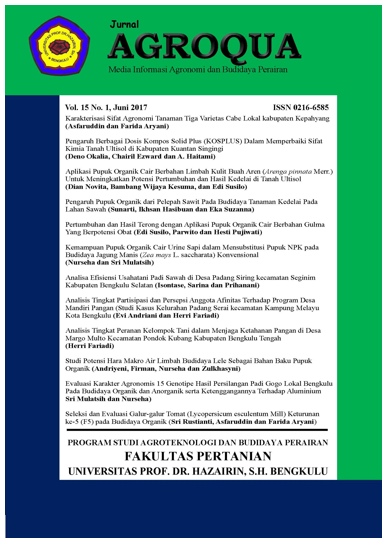Quantitative Strategic Planning Matrix On Sales Of Sukasari Coffee Powder In Bengkulu
DOI:
https://doi.org/10.32663/ja.v22i1.4433Keywords:
Ground coffee, SWOT analysis, QSPMAbstract
In the Kepahiang Regency area in Kabawetan District, there is a coffee business called Sukasari Coffee which makes processed robusta coffee into ground coffee. Increasingly tight competition with similar businesses makes it difficult for Sukasari Coffee to enter the market. So a strategy is needed to increase sales of Sukasari Coffee ground coffee in Kabawetan District. This research was conducted to (1) find out the strengths, weaknesses, opportunities and threats in the SWOT Analysis that influence the increase in Sukasari Coffee Ground Coffee Sales. (2). To find out how to formulate a marketing strategy using the Quantitative Strategic Planning Matrix (QSPM) method to increase Sukasari Coffee Ground Coffee Sales. This research uses a quantitative method using a questionnaire. The research was conducted purposively at Sukasari Coffee which is in Sukasari Village, Kabawetan District. The analysis used includes IFE, EFE, and QSPM. The research results show that the internal factor that is the main strength for ground coffee business actors is the high quality of the ground coffee. The main weakness factor is limited distribution. The external factor that is the biggest opportunity for business actors is market expansion or the development of new markets. Threatening factors are changes in policies and regulations. Sukasari Coffee chose the right strategy to increase sales of ground coffee, offering ground coffee products at varying prices through an e-commerce platform with a strong promotional strategy by utilizing wide access and reach from online sales with a TAS value of 6,127.
References
Badan Pusat Statistik Kabupaten Kepahiang, 2023.
Dahniar. (2017). Analisis swot faktor internal dan eksternal pemasaran crude palm oil (cpo ) pada PT. Gawi Makmur Kalimantan Banjarmasin. Prosiding Seminar Nasional AIMI, 27–28.
David, F. R. (2006). Manajemen Strategi. Buku 1, Edisi kesepuluh. Jakarta: Salemba Empat
Hasriani, H., Nurhapsah, N., & Yusriadi, Y. (2022). Strategi pemasaran produk kopi bubuk Mondong Dusun Buntu Riri desa Buntu Mondong Kecamatan Buntu Batu Kabupaten Enrekang. Jurnal Ilmiah Ecosystem, 22(1), 01-10.
International Coffee Organization (ICO). (2022). ICO. International Coffee Organization. London
Pratiwi, A. R., Puspitaningrum, D. A., & Widowati,I. (2020). Strategi pengembangan usaha kopi organik pada kelompok usaha bersama (KUB) Mandiri Sejahtera Ngrancah Grabag Kabupaten Magelang. Jurnal Dinamika Sosial Ekonomi, 21(2),190. https://doi.org/10.31315/jdse.v21i2.3955
Print, I., Online, I., Ode, W., Purnamasari, D., Azizu, A. M., Pertanian, F., & Buton, U. M. (2021). Strategi penjualan produk kopi bubuk jenis robusta di desa rongi sebagai upaya mendukung wisata bahari kecamatan Sampolawa kabupaten Buton Selatan. Wisata Bahari. Upaya yang dilakukan sebagai upaya untuk memberikan pelayanan dan kenyamanan. Media Agribisnis, 8479(2), 182–189.
Rangkuti, F. (2015). Analisis SWOT. Jakarta: PT. Gramedia Pustaka Utama.
Setyorini, H., Effendi, ud, & Santoso, I. (2016). Analisis strategi pemasaran menggunakan matriks SWOT dan QSPM (studi kasus: restoran WS Soekarno Hatta Malang). Jurnal Teknologi dan Manajemen Agroindustri, 5(1), 46–53.
Zakaria, A., Aditiawati, P., & Rosmiati, M. (2017). Strategi pengembangan usahatani kopi arabika (kasus pada petani kopi di desa Suntenjaya Kecamatan Lembang Kabupaten Bandung Barat, Provinsi Jawa Barat). Jurnal Sosioteknologi, 16(3), 325–339. https://doi.org/10.5614/sostek.itbj.2017.16.3.7
Downloads
Published
Issue
Section
License
Copyright (c) 2024 Selvia Selvia, Yossie Yumiati, Rika Dwi Yulihartika

This work is licensed under a Creative Commons Attribution 4.0 International License.
Authors who publish with this journal agree to the following terms:
- Authors grant the journal right of first publication with the work simultaneously licensed under a Creative Commons Attribution 4.0 Internasional (CC BY 4.0) Licence that allows others to use and share the work with an acknowledgment of the work's authorship and initial publication in this journal.
- The author(s) still hold the copyright of his/her/their work and retain publishing rights without restrictions such as (but not limited to) patent right, lecture, book and reproduce the article for own purposes.
















